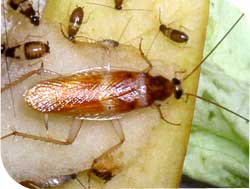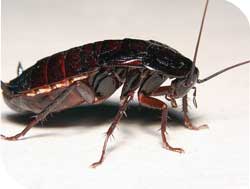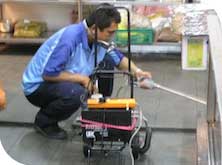Cockroaches
- Cockroaches are medium-sized to large insects in the order Dictyoptera
- They are broad, flattened insects with long antennae and a prominent, shield-shaped section behind the head called a pronotum
- A cockroach has three stages during its life cycle: egg, nymph, and adult
- Cockroaches are nocturnal, hiding during the day and becoming active at night
- All cockroaches are scavengers and will survive on almost any food as well as backing glue, leather, bookbindings, bar soap
- Cockroaches are known to carry human pathogens, such as Salmonella and E. coli, which can result in human diseases, such as food poisoning or diarrhea
Types of Cockroaches
American Cockroach(Periplaneta Americana)

- Largest cockroach species to infest buildings
- Both the adult male and female is about 1-1/2 to 2 inches long, reddish brown and possesses long wings that cover its abdomen
- A female typically produces 9 to 10 egg cases which are deposited carefully in a crack or crevice
- Each egg capsule contains about 12 young; a female and her offspring can produce over 800 cockroaches in one year.
- An American cockroach has a fondness for fermenting foods, e.g. bread soaked with beer
- Their foraging is confined mostly to the basement and ground floor of a building unless suitable conditions exist in higher locations
German Cockroach
(Blattella Germanica)

- The adult is about ½ inch long, light brown or tan, and has two dark longitudinal bands or streaks on the prothorax behind the head
- Females produce about 30 to 50 eggs at a time
- Each egg case contains about 30 young, and a female may produce a new egg case every few weeks
- The female carries the egg case until the eggs are ready to hatch
- It generally inhabits kitchens and bathrooms where they are found near plumbing fixtures, in cracks or crevices in cupboards, under drawers and kitchen sinks, and similar locations
Brown Banded Cockroach (Supella Longipalpa)

- The brownbanded cockroach is similar in size and color to the German cockroach
- It can be distinguished by the lack of brown bars on the shield in front of the wings and by the presence of two light bands across the wings and abdomen
- The adult brownbanded cockroach is about ½ inch long
- An adult male is golden brown and has a narrow body with its wings extending beyond the tip of its abdomen
- A female adult is dark chestnut brown, has a teardrop-shaped body, and its wings do not completely cover the abdomen
- Both sexes have distinctive horizontal yellow bands
- Brownbanded cockroaches prefer starchy food (e.g., glue on stamps and envelopes), are often found in offices and other places where paper is stored, and are more common in apartments or homes that are not air conditioned
- Females glue light brown egg cases, which are about 1/4 inch long, to ceilings, beneath furniture, or in closets or other dark places where eggs incubate for several weeks before hatching
- Each female and her offspring are capable of producing over 600 cockroaches in one year
Oriental Cockroach
(Blatta Orientalis)

- An adult Oriental cockroach is about 1 to 1-1/4 inches long and dark brown, almost black
- A male has fully developed wings which are shorter than the body
- A female has very short, rudimentary wings
- A female deposits an average of eight egg cases during its lifetime; each capsule produces about 16 young
- An Oriental cockroach produces a strong smell and is considered one of the dirtiest of all the cockroaches
- Commonly found in damp basements, cellars, crawl spaces, and sewers, near drains, leaky water pipes and under refrigerators, sinks, washing machines, and floors
- It feeds on all types of garbage and other organic material
Signs of Infestation
Cockroaches Carcasses

Live Cockroaches

Skin Caste

Egg Cases (Ootheca)

Parts and Pieces

Droppings

Cockroaches Management
Residual Spraying
Residual insecticide sprays leave a toxic deposit on surfaces and will kill cockroaches for a certain time period, usually two to four weeks.
It is sprayed in precise, specific sites in cracks and crevices behind sinks, cabinets, around drains and plumbing
Chemical Baiting

- Baits can be placed exactly where they are most effective, especially in foraging and harborage areas
- Insecticidal paste and gel formulations are injected into cracks and crevices or into wall voids to attain maximum exposure
- Baits are often slow acting, the cockroaches that die from direct kill do so after they have returned to harborage areas, often after they have eliminated some of the bait through their feces
- The fecal material and the dead cockroaches themselves are then consumed by other cockroaches, which are then also killed by the active chemical ingredient of the bait
ULV Misting

- ULV misting is a non-residual insecticide sprays that eliminate cockroaches only on contact
- They irritate cockroaches and can flush the pests out of their hiding places and force them into areas treated with a residual insecticide
Cockroach Trap

- Cockroach traps, small, open-ended boxes, contain an attractant and sticky substance that retains the insects once they enter
- Traps are most effective when placed against walls under sinks, in cabinets and in basement corners



